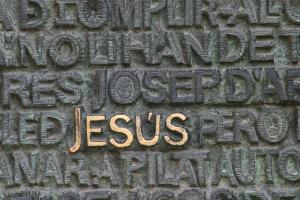
What is Truer than Truth?
The answer: A story.
Once upon a time, there was a man named Jesus, and the rest, according to Reza Aslan’s book, Zealot, is just history. When historians like Reza Aslan treat us to the un- romantic version of Jesus of Nazareth who walked on land, as opposed to the romantic version of a Jesus Christ who walked on water, I have a blasphemous urge to ask, what does history have to do with it? History is about facts, not truths. And Religious truths are not about what literally happened, but about what we believe actually happened. It’s about the story.
When you expose a reader to what goes on behind the scenes, you not only perniciously destroy the magic, but you also destroy the meaning. It’s not unlike trying to watch a spectacular movie, only to be interrupted with a play by play of the special effects.
All religions employ special effects to reveal universal and timeless truths. Once we recognize this, we will spend less time agonizing about the historical and technical details and more time immersing ourselves into the message and it’s magic.
The sacred is transcendent. Applying the laws of nature to the laws of a timeless metaphysical reality, is not only futile but supercilious. No where is the futility of this exercise more apparent than our conversations about the historical Jesus.
I, by virtue of being a Muslim like Reza, am obligated to believe in the Immaculate Conception but not the Crucifixion. Post history lesson, I am now forced to contend with the immaculate misconceptions surrounding a historical Jesus.
We know that historically it was the early Christian church that transformed Jesus from a revolutionary to a spiritual figure and memorialized him with universal principles like “love your enemy.” And although the identity of Jesus became a contest between Paul, who dismissed the Law of Moses as irrelevant to salvation, and James, who said that the law was a requirement of belief in Jesus Christ, it was Paul’s version that eventually prevailed, when the council of Nicaea codified the teachings we now refer to as Christianity.

The truth is, I love Jesus, not just the man, but the metaphor, not just the revolutionary Jesus, but the spiritual one. And I do not like the idea that history can take that away.
When the Council of Nicea issued its official creed, they were not stealthily doing so to suppress political dissent, they were just upholding majority opinion at the time. Paul was popular. He was popular because he divorced Jesus from the law and provided gentiles with a theology they could embrace.
And who could blame them. Jesus the metaphor of peace and love, minus the law is an approachable Jesus. He is a Jesus that a Muslim like me not only loves but can also channel, even if I am constantly reminded by my, ‘Jesus Loves You’, bumper sticker wielding, bible belt community, that Jesus does not love me back. That’s okay, because in the spirit of Jesus, Paul’s Jesus, I forgive them. I can afford to forgive just as they can afford to forget that no one can or has ever had a monopoly on Jesus, not even influential historians like Reza Aslan. Jesus is as Jesus lovers do.
The irony and perhaps the unintended consequence of history’s attempt to uncover the true identity of Jesus of Nazareth was the resurrection of Jesus the Christ. Because only after we are done learning about Jesus the man, does Reza Aslan’s book evolve from a history book, to a book about the human capacity to connote abstract concepts, like salvation, from concrete, otherwise mundane events, like life and death. Only then does it become a book about how it is the subjective consensus of the majority that determines the final verdict on religion and God, and not history. Only then does it become about why big truths can and do override inconvenient facts.
Although Jesus came to re-establish the Law of Moses, when the Law of Moses stood in the way of the bigger picture, Paul did away with the law, so that the bigger picture may prevail. And what is the bigger picture?
The bigger picture is that salvation is not about calculating ways to secure a piece of heaven’s real estate. No, salvation is about the capacity of individual minds to inspire the collective consciousness. It’s about delivering metaphors that will salvage us from the grim reality of life on earth. In the case of the Christian narrative, the bigger picture is that Jesus the man, does not save, but Jesus the metaphor, saves every single day until the end of time. Jesus saves by intervening in the hearts of men and women with his radical call to mercy. Jesus saves by stopping us from perpetuating the vicious cycle of vengeance and hate.
The fact that we know less about Jesus the man, than we do about Jesus the metaphor; the metaphor of mercy, the metaphor of unconditional love, the metaphor of poverty and prayer, is in my opinion, what has sustained Christianity. Christianity could have died out, if Paul’s version did not prevail.
For Jesus did not fulfill the prophetic vision the Jews were expecting. He did something far more radical. He taught us that religion is a metaphor; Not to be defined by its history or its heretics, but by the collective and subjective consciousness of its adherents. He taught us that religion is the art of selective perception, where compassion should override conflict.
That is the point of religion that history cannot make.
Religion can only survive as long as it breathes through the hearts and minds of its adherents. Ironically, this book of history may have had the opposite of its intended effect. For rather than demystifying religion by inundating us with facts, it has served as a reminder that religion must depend less on facts and more on the three R’s of religious jurisprudence: reality, revelation, and romance, the rest dear reader, is (just) history.















